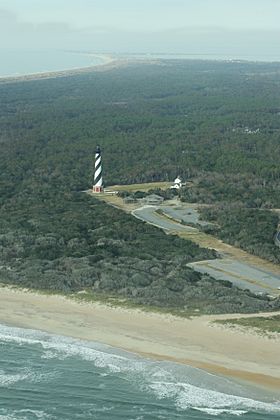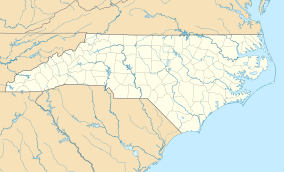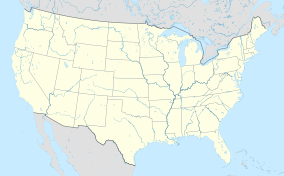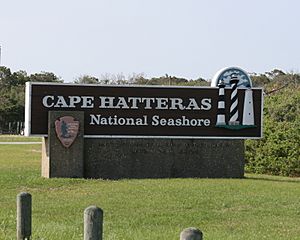Cape Hatteras National Seashore facts for kids
Quick facts for kids Cape Hatteras National Seashore |
|
|---|---|
|
IUCN Category V (Protected Landscape/Seascape)
|
|
 |
|
| Location | Outer Banks, Dare County & Hyde County, North Carolina, USA |
| Nearest city | Nags Head, North Carolina |
| Area | 30,351 acres (122.83 km2) |
| Established | January 12, 1953 |
| Visitors | 2,862,844 (in 2022) |
| Governing body | National Park Service |
| Website | Cape Hatteras National Seashore |
Cape Hatteras National Seashore is a special protected area in the United States. It covers a long stretch of the Outer Banks in North Carolina. This beautiful area goes from Bodie Island all the way to Ocracoke Island. That's about 70 miles (113 km) of amazing coastline!
The National Park Service takes care of this seashore. It includes parts of the barrier islands along N.C. 12. You'll find other cool places nearby, like Pea Island National Wildlife Refuge. There are also towns like Rodanthe, Buxton, and Ocracoke.
Cape Hatteras is famous for its natural beauty and rich history. It's a great place for many fun activities. This area was once called the "Graveyard of the Atlantic." This is because of its strong currents, shallow sandbars, and big storms. You can learn about many shipwrecks and lighthouses here. The US Lifesaving Service also has a long history in this area.
The islands are home to many different plants and animals. They are a very important spot for birds that travel south for winter. Many people think the fishing and surfing here are the best on the East Coast!
Contents
Discovering Cape Hatteras History
Cape Hatteras National Seashore was created by the US Congress. This happened on August 17, 1937. A very generous person named Paul Mellon helped buy much of the land. He was a multi-millionaire who loved to help good causes.
The park's name changed on June 29, 1940. It became the Cape Hatteras National Seashore Recreational Area. This change allowed people to hunt in certain areas. This was a new idea for a park managed by the National Park Service.
The park officially opened on January 12, 1953. It was the very first national seashore in the country! A special ceremony happened on April 24, 1958. Today, it works with two other Outer Banks parks. These are Wright Brothers National Memorial and Fort Raleigh National Historic Site. The main office for all three parks is at Fort Raleigh.
Nature and Wildlife at Cape Hatteras
Cape Hatteras National Seashore is a special place for nature. The main types of plants here are Live oak trees and Sea Oats. Sea Oats are a type of grass that grows on beaches. This area is like a coastal prairie.
One part of the seashore, near Rodanthe, has a lot of beach erosion. This means the sand is washing away quickly.
Explore the Visitor Centers
There are three visitor centers at Cape Hatteras National Seashore. Each one is on a different barrier island. These centers are great places to start your visit. They offer helpful information about the seashore. You can also join ranger programs and find cool books.
- The Bodie Island Visitor Center is in the northern part of the seashore. It's right next to the Bodie Island Lighthouse. You can often take tours of the lighthouse during certain times of the year.
- The Hatteras Island Visitor Center and Museum of the Sea is in Buxton, North Carolina. It's located in the old house where the Cape Hatteras Light keeper used to live. Inside, you can see exhibits about the history of the Outer Banks. You'll learn about its sea history and natural world.
- The Ocracoke Island Visitor Center is in Ocracoke, North Carolina. It's close to the Ocracoke Lighthouse.
Protecting the Beaches and Wildlife

Cape Hatteras National Seashore works hard to protect its beaches. This is especially important for shorebirds and sea turtles. These animals build their nests on the sand.
Sometimes, rules are put in place to help protect these nesting animals. For example, some beach areas might be closed to vehicles. This happens during the months when birds and turtles are nesting. This helps keep their nests safe.
In 2012, the National Park Service created a new plan. This plan helps manage how people use the beaches. It balances fun activities with protecting wildlife. Some parts of the beach are open to vehicles all year. Other parts are just for walking and enjoying nature. This way, everyone can enjoy the seashore while keeping it safe for animals.
Climate and Weather at Cape Hatteras
Cape Hatteras National Seashore has a warm and humid climate. Summers are hot and sticky. Winters are cool but not usually freezing. It rains throughout the year.
In summer, a cool ocean breeze often blows in the afternoon. This helps to cool things down. But sometimes it can get very hot and humid.
The seashore can get hit by hurricanes. These big storms usually happen from June to November. They are most common in late August and September. In winter, it can get cold and windy.
The average yearly temperature is about 63 degrees Fahrenheit (17 degrees Celsius). It doesn't snow much here, usually less than 2 inches (5 cm) a year. The ocean water around Cape Hatteras is also warm in summer. It can reach about 80 degrees Fahrenheit (27 degrees Celsius) in August.
Images for kids





